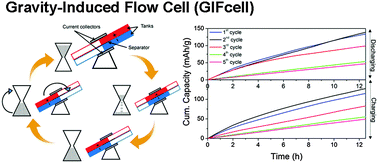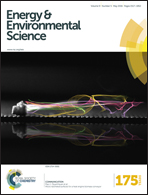A low-dissipation, pumpless, gravity-induced flow battery†
Abstract
Redox flow batteries have the potential to provide low-cost energy storage to enable renewable energy technologies such as wind and solar to overcome their inherent intermittency and to improve the efficiency of electric grids. Conventional flow batteries are complex electromechanical systems designed to simultaneously control flow of redox active fluids and perform electrochemical functions. With the advent of redox active fluids with high capacity density, i.e., Faradaic capacity significantly exceeding the 1–2 M concentration equivalents typical of aqueous redox flow batteries, new flow battery designs become of interest. Here, we design and demonstrate a proof-of-concept prototype for a “gravity-induced flow cell” (GIFcell), representing one of a family of approaches to simpler, more robust, passively driven, lower-cost flow battery architectures. Such designs are particularly appropriate for semi-solid electrodes comprising suspensions of networked conductors and/or electroactive particles, due to their low energy dissipation during flow. Accordingly, we demonstrate the GIFcell using nonaqueous lithium polysulfide solutions containing a nanoscale carbon network in a half-flow-cell configuration and achieve round trip energy efficiency as high as 91%.


 Please wait while we load your content...
Please wait while we load your content...